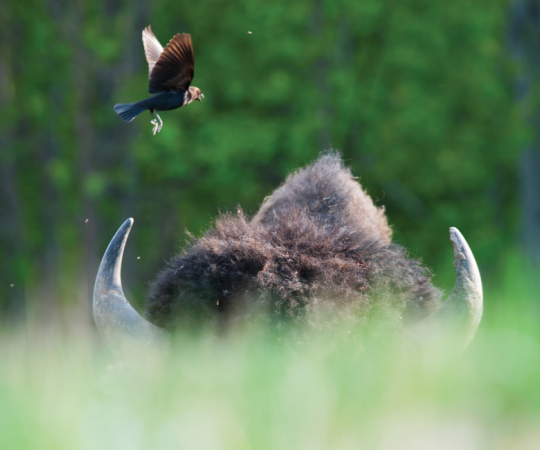Things were shaking, rumbling, vibrating – a space encapsulated, tumbling uncontrollably, like a car rolling off a highway. A roar beyond the edges closing in; unrelenting confusion; craziness. And then the instant where my stifled scream broke free and the dream was gone. Sitting bolt upright in my sleeping bag, gun in my hand, my world was defined by a domed envelope of yellow nylon.
“BEAR!” I bellowed, grabbing the zipper on the doorway. The stillness of that moment was broken by the ripping of the zipper teeth. The tent door fell away, revealing a very black and moist nose, straddled by two wide and startled eyes. In the space of three pulls on the trigger, two things became certain: A bear had died in the High Arctic, and I was fully awake, bent forward in my sleeping bag.
It was August 1994. The location: Coburg Island off the southeast coast of Ellesmere Island, where I was studying a huge colony of murres and kittiwakes. The day had been busy and exhausting, most of it spent dangling in a harness high above the sea, banding seabirds and their chicks.
Stumbling out of the tent in my underwear, smoking gun in hand, everything was a blur. I heard my tent-mate shout, “Steve, you didn’t even fire a warning shot!”
And as I stood over the glistening and motionless remains of the magnificent animal, I realized that it was wet and fresh from the sea. Looking at my watch I also realized that it was midnight and that I’d only gone to bed 15 minutes earlier. It was true. I hadn’t fired a warning shot. Nor had it occurred to me.
For an Arctic wildlife biologist, killing a polar bear – regardless of whether it’s in self-defence – is traumatic. My friends and anyone who knew the story tried to reassure me: “What choice did you have in such close quarters?” But still, I had my misgivings, and couldn’t help feeling I did have another choice.
I tested that suspicion 11 years later. Teamed up with three other researchers, I was studying seabirds on a small colony off southern Baffin Island. I was adjusting our bear-alarm fence when 200 kilograms of white bear skidded to a stop right beside me – and right overtop of my gun. The bear hesitated and my instincts took over. Raising my arms high, I arched my body and roared out: “RRAAAHH!” The bear, a three-year-old male, flinched, his head recoiling as though he’d been punched. But then I retreated a single step backwards. And the bear stepped forward. With every slow, retreating step of mine, the bear advanced a step, our eyes locked on each other through a half metre of violated personal space.
Moments later, backed up against a rock outcrop, I thought my time had come. That was when a shot rang out and the animal collapsed in a bloody heap.
Of course, I’ll be forever grateful to my camp-mates who saved my life. But there was something about the way the bear flinched when I shouted and roared at it, something about the brief flicker in its eyes, that I couldn’t shake.
A FEW YEARS LATER I met Nikita Ovsyanikov, a behavioural scientist who’s been living with polar bears in a wildlife reserve in northernmost Siberia for over 20 years. Wrangel Island, his study site, is one of the world’s largest, busiest polar bear denning sites, but Ovsyanikov wanders the island freely, unarmed.
Polar bears, he says, are inherently afraid of people. To them, humans are “big, active, and a danger to them, and they have to keep their distance.” They may be carnivores and fearsome predators, but in some ways polar bears can be more vulnerable than their omnivorous cousins, says Ovsyanikov.
“Even a serious wound for a brown bear may not be so fatal and dangerous, because they will still be able to feed on grass. But polar bears will lose the ability to hunt [if they’re hurt], and they will die. And this means that [polar bears] should be very cautious and very careful. And that is what they are.”
Like humans, polar bears are social animals that communicate through body language, he says. They can read fear in others. They respond to noises, gestures and facial expressions. And, in turn, they can be intimidated.
Before heading out for a day of observing bears, Ovsyanikov always checks in on himself: “How confident do I feel today?” If polar bears detect fear, they’re more likely to attack. Hence his golden rule: If he’s having an off-balance day, he’ll stay inside the research cabin.
He’s tested that theory with more than 2,000 polar bear face-offs at his study site. The best defence and all-around deterrent, he says, is simply a hefty stick and a no-nonsense attitude. He’s watched walruses lunge at polar bears with their tusks, and applies the same tactic, holding up his stick at bears that get too close.
Today’s other Wrangel Island bear biologists have adopted what Ovsyanikov calls “walrus defence”: None of them carry guns. And this approach is nothing new. Ovsyanikov says subsistence hunters living on the coast of the Chukotka Peninsula have traditionally fended off polar bears with nothing more than sticks and assertive body language. “These guys do not use rifles,” he says.
NOW THAT I'VE HAD YEARS to ponder my own close encounters, and have spent more time watching animals in the wild, I’d have to say the Ovsyanikov approach makes perfect sense. I’m not fearful of the idea of another standoff with a polar bear. I remember well that flinch of fear in my predator’s retinas when I bellowed out at him. The bear was visibly terrified. And after talking to Ovsyanikov, I realize that in betraying my own terror, I prompted a self-fulfilling prophecy: I knew I was going to die, and this conviction incited the bear. So perhaps the real challenge for a human meeting up with an inquisitive polar bear is something completely primal. Maybe it’s simply about dismissing from your mind “the myth of the Arctic man-eater.









